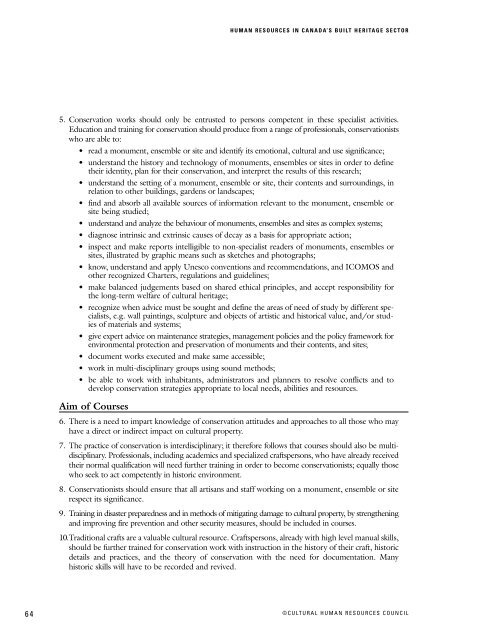Human Resources in Canada's Built Heritage Sector: Mapping the ...
Human Resources in Canada's Built Heritage Sector: Mapping the ...
Human Resources in Canada's Built Heritage Sector: Mapping the ...
- No tags were found...
You also want an ePaper? Increase the reach of your titles
YUMPU automatically turns print PDFs into web optimized ePapers that Google loves.
HUMAN RESOURCES IN CANADA’S BUILT HERITAGE SECTOR5. Conservation works should only be entrusted to persons competent <strong>in</strong> <strong>the</strong>se specialist activities.Education and tra<strong>in</strong><strong>in</strong>g for conservation should produce from a range of professionals, conservationistswho are able to:• read a monument, ensemble or site and identify its emotional, cultural and use significance;• understand <strong>the</strong> history and technology of monuments, ensembles or sites <strong>in</strong> order to def<strong>in</strong>e<strong>the</strong>ir identity, plan for <strong>the</strong>ir conservation, and <strong>in</strong>terpret <strong>the</strong> results of this research;• understand <strong>the</strong> sett<strong>in</strong>g of a monument, ensemble or site, <strong>the</strong>ir contents and surround<strong>in</strong>gs, <strong>in</strong>relation to o<strong>the</strong>r build<strong>in</strong>gs, gardens or landscapes;• f<strong>in</strong>d and absorb all available sources of <strong>in</strong>formation relevant to <strong>the</strong> monument, ensemble orsite be<strong>in</strong>g studied;• understand and analyze <strong>the</strong> behaviour of monuments, ensembles and sites as complex systems;• diagnose <strong>in</strong>tr<strong>in</strong>sic and extr<strong>in</strong>sic causes of decay as a basis for appropriate action;• <strong>in</strong>spect and make reports <strong>in</strong>telligible to non-specialist readers of monuments, ensembles orsites, illustrated by graphic means such as sketches and photographs;• know, understand and apply Unesco conventions and recommendations, and ICOMOS ando<strong>the</strong>r recognized Charters, regulations and guidel<strong>in</strong>es;• make balanced judgements based on shared ethical pr<strong>in</strong>ciples, and accept responsibility for<strong>the</strong> long-term welfare of cultural heritage;• recognize when advice must be sought and def<strong>in</strong>e <strong>the</strong> areas of need of study by different specialists,e.g. wall pa<strong>in</strong>t<strong>in</strong>gs, sculpture and objects of artistic and historical value, and/or studiesof materials and systems;• give expert advice on ma<strong>in</strong>tenance strategies, management policies and <strong>the</strong> policy framework forenvironmental protection and preservation of monuments and <strong>the</strong>ir contents, and sites;• document works executed and make same accessible;• work <strong>in</strong> multi-discipl<strong>in</strong>ary groups us<strong>in</strong>g sound methods;• be able to work with <strong>in</strong>habitants, adm<strong>in</strong>istrators and planners to resolve conflicts and todevelop conservation strategies appropriate to local needs, abilities and resources.Aim of Courses6. There is a need to impart knowledge of conservation attitudes and approaches to all those who mayhave a direct or <strong>in</strong>direct impact on cultural property.7. The practice of conservation is <strong>in</strong>terdiscipl<strong>in</strong>ary; it <strong>the</strong>refore follows that courses should also be multidiscipl<strong>in</strong>ary.Professionals, <strong>in</strong>clud<strong>in</strong>g academics and specialized craftspersons, who have already received<strong>the</strong>ir normal qualification will need fur<strong>the</strong>r tra<strong>in</strong><strong>in</strong>g <strong>in</strong> order to become conservationists; equally thosewho seek to act competently <strong>in</strong> historic environment.8. Conservationists should ensure that all artisans and staff work<strong>in</strong>g on a monument, ensemble or siterespect its significance.9. Tra<strong>in</strong><strong>in</strong>g <strong>in</strong> disaster preparedness and <strong>in</strong> methods of mitigat<strong>in</strong>g damage to cultural property, by streng<strong>the</strong>n<strong>in</strong>gand improv<strong>in</strong>g fire prevention and o<strong>the</strong>r security measures, should be <strong>in</strong>cluded <strong>in</strong> courses.10.Traditional crafts are a valuable cultural resource. Craftspersons, already with high level manual skills,should be fur<strong>the</strong>r tra<strong>in</strong>ed for conservation work with <strong>in</strong>struction <strong>in</strong> <strong>the</strong> history of <strong>the</strong>ir craft, historicdetails and practices, and <strong>the</strong> <strong>the</strong>ory of conservation with <strong>the</strong> need for documentation. Manyhistoric skills will have to be recorded and revived.64©CULTURAL HUMAN RESOURCES COUNCIL










